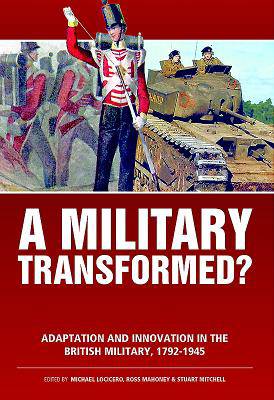
- Afhalen na 1 uur in een winkel met voorraad
- Gratis thuislevering in België vanaf € 30
- Ruim aanbod met 7 miljoen producten
- Afhalen na 1 uur in een winkel met voorraad
- Gratis thuislevering in België vanaf € 30
- Ruim aanbod met 7 miljoen producten
Zoeken
A Military Transformed?
Adaptation and Innovation in the British Military, 1792-1945
€ 41,95
+ 83 punten
Omschrijving
Between 1792 and 1945, the character of warfare changed. Battalions standing shoulder to shoulder during the Napoleonic era gave way to the industrialized, modern armies of the First and Second World Wars. The organization and operational methods of the major military powers dramatically altered during this period and the British forces were no different. From the transition of the Royal Navy's ships to oil from coal to the creation of an independent air force in 1918, the British military pioneered key innovations that affected the character of war on land, sea and air. To date, many commentators and historians have focused on contemporary debates or specific historical examples. A Military Transformed? Adaptation and Innovation in the British Military from 1792 to 1945 brings many of these debates together and forms a broader picture. The complexity of change in the British Army, Royal Navy and Royal Air Force is explored in chapters drawing on new and original research. Examples covered include the British military performance in the Napoleonic Wars, the developments of the Army medical services in the late-nineteenth century, the Royal Navy's introduction of the Whitehead torpedo in the 1870s, air power doctrine on the eve of the First World War, British Army reorganization in 1918 and amphibious operations in the Second World War. Spanning the period of both peace and war this ground-breaking survey illustrates the different drivers for transformation and innovation. Culture, technology, tactics, organization, personality, doctrine, command and context have all shaped the speed and development of the British Forces. A Military Transformed? Adaptation and Innovation in the British Military from 1792 to 1945 shows that while it was neither a revolutionary nor a conservative organization, the British military certainly evolved and reacted to the character of warfare in the nineteenth and early twentieth centuries; even if change, at times, did not come easily.
Specificaties
Betrokkenen
- Uitgeverij:
Inhoud
- Aantal bladzijden:
- 256
- Taal:
- Engels
- Reeks:
- Reeksnummer:
- nr. 3
Eigenschappen
- Productcode (EAN):
- 9781911096702
- Verschijningsdatum:
- 13/10/2016
- Uitvoering:
- Paperback
- Formaat:
- Trade paperback (VS)
- Afmetingen:
- 152 mm x 235 mm
- Gewicht:
- 408 g

Alleen bij Standaard Boekhandel
+ 83 punten op je klantenkaart van Standaard Boekhandel
Beoordelingen
We publiceren alleen reviews die voldoen aan de voorwaarden voor reviews. Bekijk onze voorwaarden voor reviews.










